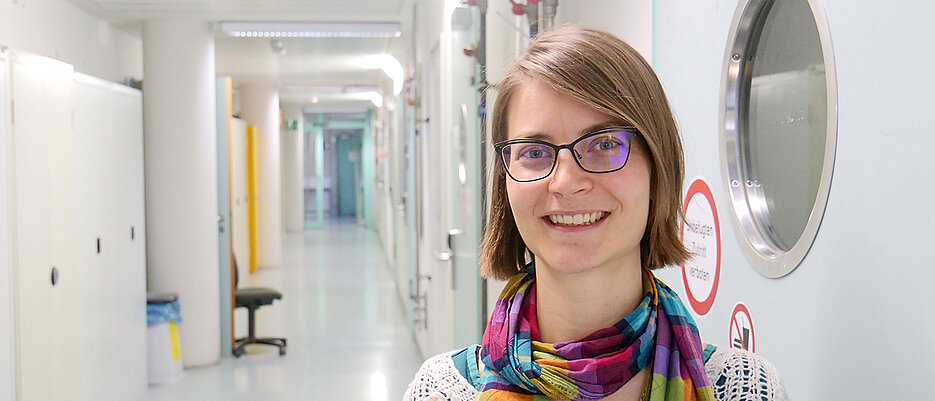Taking Insects on a Virtual Journey
12/04/2023How do flies and ants find their way? Neuroscientist Hannah Haberkern is investigating this question with a new Emmy Noether independent junior research group. To do this, she has moved from the USA to Würzburg.

When a foraging fly comes across a rotten piece of fruit, it has to decide whether it is satisfied with this food source or whether it continues its search. If it decides to continue its flight but does not discover a better alternative, it has to find its way back to the piece of fruit - even if landmarks such as the sun have long since disappeared behind dark clouds.
How do insects like the fruit fly Drosophila and desert ants manage to orient in their environment and purposefully head for specific locations? This is what neuroscientist Dr Hannah Haberkern is investigating in a new research project at Julius-Maximilians-Universität Würzburg (JMU).
Funded by the German Research Foundation (DFG) with around two million euros, she can now set up her own Emmy Noether independent junior research group. She has six years to conduct detailed research into "behavioural strategies and neuronal mechanisms for robust navigation" - the name of her project.
A Road Map of the Fly Brain
"I am interested in how these insects manage to navigate accurately under changing environmental conditions despite their comparatively small nervous system": this is how Haberkern describes her central research question. Her aim is to decipher down to the individual nerve cell which parts of the nervous system control behaviour, how these neural circuits carry out the underlying computations, and how informative signals is filtered out - from the arrival of an optical stimulus in the eye to processing in the central part of the fly brain.
What helps her is the fact that the Drosophila brain is quite small: it consists of around 200,000 neurons and tens of millions of connections between them. While this a highly complex system, this is not much compared to the brain of a mouse and its 70 million neurons - not to mention the human brain, which is made up of 80 to 100 billion nerve cells.
Fundamental research findings that Haberkern was involved in at her previous research centre, the HHMI Janelia Research Campus near Washington DC (USA), are also helpful. Over the past few years, a team of scientists there, in collaboration with Google, has mapped the neurons and synapses of a part of the fly brain, creating a comprehensive circuit diagram called a connectome.
A Close Look at Information Processing
The teams focused on the central complex, a brain region that plays an important role in navigation. They identified a number of new neuron types and located neuronal circuits that apparently help flies to find their way around the world.
Anyone wondering whether this answers all the questions is wrong. "You have to understand the connectome as a kind of road map on which all roads, paths and intersections are marked," says the scientist. However, with the map in hand alone, it is still far from clear how the traffic flows there - metaphorically speaking - or how, in the case of the fly, information is processed and behaviour is controlled.
Video Games for Flies and Ants
Dexterity and a steady hand are required when Hannah Haberkern handles her flies, which are just a few millimetres in size, in the laboratory. "I'm investigating their ability to orientate themselves in a virtual environment," she explains her approach. The insects are fixed under a microscope in such a way that they can walk on a tiny ball that rotates in a stream of air with virtually no resistance. This treadmill for flies allows flies to walk the spot while Haberkern observes their brains.
Depending on the virtual environment Haberkern presents the flies with, they change the direction in which they run and therefore the direction in which the ball moves under their legs. Haberkern can read from this where the fly has turned and what distance it is travelling. At the same time, she uses a special examination technique to record the activity of the nerve cells in the fly's brain and thus obtain an exact image of the neuronal processes involved.
Even though it is a virtual environment, it looks deceptively real. "I try to bring important aspects of the natural environment into the laboratory to study the behaviour and neural processing of insects under quasi-real conditions," says Haberkern. The position of the sun, clouds, grasses, shadows cast: the scientist takes these and many other aspects into account. In her experiments with ants, she can build on field trials carried out by research teams from the University of Würzburg, among others.
Return to the University of Würzburg
Hannah Haberkern lived and researched abroad for 14 years: from 2009 to 2012 for her Master's degree in Computational Biology and Bioinformatics at ETH Zurich in Switzerland and subsequently as a doctoral student and postdoc in the field of neuroscience at the University of Cambridge (UK) and at the HHMI Janelia Research Campus in the USA. Nevertheless, she is no stranger to the University and the city of Würzburg: She completed her Bachelor's degree in Biomedicine here from 2006 to 2009.
Of course, sentimental memories of this time were not the reason why Hannah Haberkern came to JMU with her Emmy Noether group. "At the University of Würzburg, everything I need for my research is available under one roof," she says.
From experts in the field of physiology and behavioural research on desert ants and Drosophila to the necessary technology, such as electron microscopy tailored to insects, and many years of experience in breeding and keeping these animals, JMU offers exactly the environment she needs to hit the ground running.
Contact
Dr. Hannah Haberkern, Emmy Noether Junior Research Group: Behavioural Strategies and Neuronal Mechanisms for Robust Navigation, T: +49 931 31-88604, hannah.haberkern@uni-wuerzburg.de






